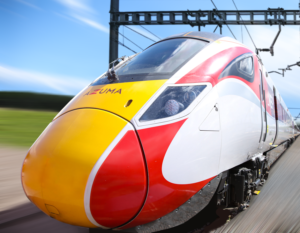Alex Burrows, Director of BCRRE, introduces BCRRE’s Rail Decarbonisation week

Last week, with all of the other news going on, many will have missed the UK Government’s policy paper, Decarbonising Transport: Setting the Challenge that sets out the Department for Transport’s strategy for developing their Transport Decarbonisation Plan which will be published later in 2020. Of the six strategic priorities for the Transport Decarbonisation Plan, my eye was naturally caught by the priority titled UK as a hub for green transport technology and innovation. As one of the world’s largest specialist railway research, education and innovation centres, we are well-placed to support the national agenda for delivering decarbonisation and are already leading the way in developing solutions for the railway in the UK and across the world.
Rail is, of course, a relatively low-carbon form of transport: it makes up just 1.4% of the UK’s domestic transport emissions while delivering 10% of all passenger miles travelled (2018, sourced from the DfT’s policy paper). But there is plenty that can still be done to improve on that. Less than 40% of the UK railway network is electrified, and although 100% electrification is unfeasible, electric trains provide significant operating benefits including better performance and comfort, lower operating costs and less noise. New trains such as the Azuma (pictured below) are being introduced successfully onto the network, making rail transport more appealing to the travelling public. The railway can – and will – decarbonise to support the requirement for the UK to achieve Net Zero emissions by 2050.

The DfT policy paper has been published at a timely point for us at BCRRE as we are currently developing new plans (following the COVID-19 issue) for an online launch of our new BCRRE Centre of Excellence in Rail Decarbonisation. Decarbonisation is one of two railway grand challenges (along with digitalisation) that needs a strategic, whole-sector approach with government, industry and academia working together to utilise knowledge in order to develop ideas to address these grand challenges. These ideas will exploit developing technology in order to generate innovative solutions that will, in turn, help us achieve the outcomes we seek in responding to these grand challenges. To support decarbonisation of the railway, academia needs to be providing the ideas and the knowledge to drive innovation. Here at BCRRE we are intent on rising to that challenge, demonstrated by a number of cutting-edge projects including the industry partnership with Porterbrook that delivered HydroFLEX, the UK’s first hydrogen train.
This week we will be introducing our Centre of Excellence in Rail Decarbonisation with a series of blog posts from our lead academics that will set out our 5 core capability areas for the Centre:
- Sustainable Traction Systems, led by Dr Stuart Hillmansen
- Power Electronics, led by Dr Pietro Tricoli
- Climate Adaptation and Rail Resilience, led by Dr Andrew Quinn
- Aerodynamics, led by Dr David Soper
- Sustainable Infrastructure and Asset Management, led by Dr Sakdirat Kaewunruen and Dr Michael Burrow
These will give you a flavour of the range of projects we undertake and the capabilities we offer at BCRRE. However, our new Centre of Excellence in Rail Decarbonisation does more than just research; we are a practical team and can also work in partnership with industry on innovation projects, as well as provide broader enterprise support and supply chain engagement through our Digi-Rail project and Rail Alliance activities.
If you would like to find out more, please email us at: railway@contacts.bham.ac.uk
For up-to-date news and views visit our Twitter page @bcrre and LinkedIn page www.linkedin.com/company/bcrre/

Dear Sirs,
Rail is the least carboned of modes but suffers a limitation in granularity. It is too big (vehicles & infrastructures) to:
a) reach everywhere in a territory
b) be available 24/7
c) carry not only people but goods.
Mostly for those 3 reasons is it about impossible to reduce the automotive traffic. May I suggest you a reading on the CarLina solution, developed for cities to repel this traffic some 20km away from cities.
We do that to fight pollution, solving congestion as a side effect, but this also happens to perfectly complement rail. Imagine a very efficient, available, inexpensive way of branching to 20km around railway stations.
Please have a look at the CarLina page (URL below). We already are in touch with the Leeds City Region future mobility zone, they were impressed with the possibilities to expand their program ambitions.
Best Regards,